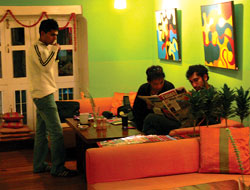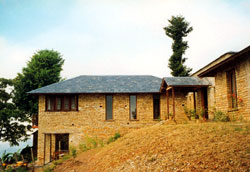|
|
I'm not an expert in adobe, nor a hard-line supporter of alternative construction methods, or eco-building. I have, however, always set high priority on minimising environmental impact during the selection of construction materials by paying attention to their origin and using locally-produced materials whenever possible.
The extensive use of materials like scarce sal wood, or marble transported all the way from Rajasthan is not very PC. Further, a glimpse at our towns and cities makes it clear that we are stuck and running out of ideas stylistically.
That is where I have a lot of sympathy for someone trying to bring in new ideas. However, it would not serve much purpose if ideas like adobe and other alternative building methods get stuck at an experimental or namuna ghar phase.
What should our target group be for adobe? Should the rural Nepali builder be encouraged to continue building using indigenous material and construction methods, or should builders of urban (residential) constructions be made aware of alternative construction methods and styles? If the latter, this should be propagated as a sort of coming home to a complete architectural archetype, not simply sticking on dacchi appa as a nod to tradition, but also allowing the alternative material dictate more than only looks.
 We have essentially discarded our knowledge of conventional adobe methods which, combined with new technologies, could have been used as a springboard to innovatively meet emerging challenges.
We have essentially discarded our knowledge of conventional adobe methods which, combined with new technologies, could have been used as a springboard to innovatively meet emerging challenges.
Architects have to deal with shyness, and even aversion towards different construction methods and design. We see substantial older adobe buildings getting knocked down, when they could as easily be adapted to meet changed requirements. There are classy examples around the city, like Caf? Mitra (centre).
The ever-so-popular conventional 'pillar system' house still has seriously deep foundations. After all, it has positives that any builder can swear by: it is considered structurally sound, socially acceptable, and a non-risk investment.
The success of alternative building methods will lie in their economic advantages. Durability, ability to adapt to specific designs, the flexibility to meet modern requirements in wet areas such as kitchens and bathrooms, and lower cost of maintenance will determine success.
A significant challenge also lies in the willingness or capability of a contractor to build with non-conventional materials in urban areas. There are problems of rates, financial margins, and even lost skills.
|
|
There are magnificent recent examples of adobe and other alternative construction materials combined with contemporary materials to achieve very modern designs. There are a few corporate clients in tourism, such as Tiger Mountain (top right), who have ventured into eco-construction and received international acknowledgement and awards for ecologically-sustainable building. Most of these examples have resulted from the necessity to deal with economic factors and local situations, like difficult access to the construction market.
Our building culture is monotonous, resulting in a cityscape we wish were different, to say the least. What we see now is the result of indifference and lack of innovation from the planners\' side, and inflexibility and often conceit from the clients. The biggest challenge in using alternative building method will be convincing the client.
There are practical and engineering constraints to using adobe too. For one, it would probably only work for buildings under a certain size and designed for limited use. How would it function with large floor spans, or multi-storeyed buildings? Are there are examples of commercial urban structures built using it? (It would be exciting to shop in a 'muddy good' supermarket.) Can it be combined with other materials like concrete and steel structure? And don't forget the bureaucracy, whether and how adobe would comply with the 'stringent' building codes of our municipalities is probably a chapter of its own. We will also need daring clients, willing to break with the norm and not listen to family, friends etc.
It would be great to see Nepali building culture create a new identity, and adobe and other alternative building methods must surely part of it. But to do that, and not just build a few stand-alone model houses, we need awareness and real, informed debate on all our choices.
Prabal Thapa is an architect practicing in Kathmandu.




